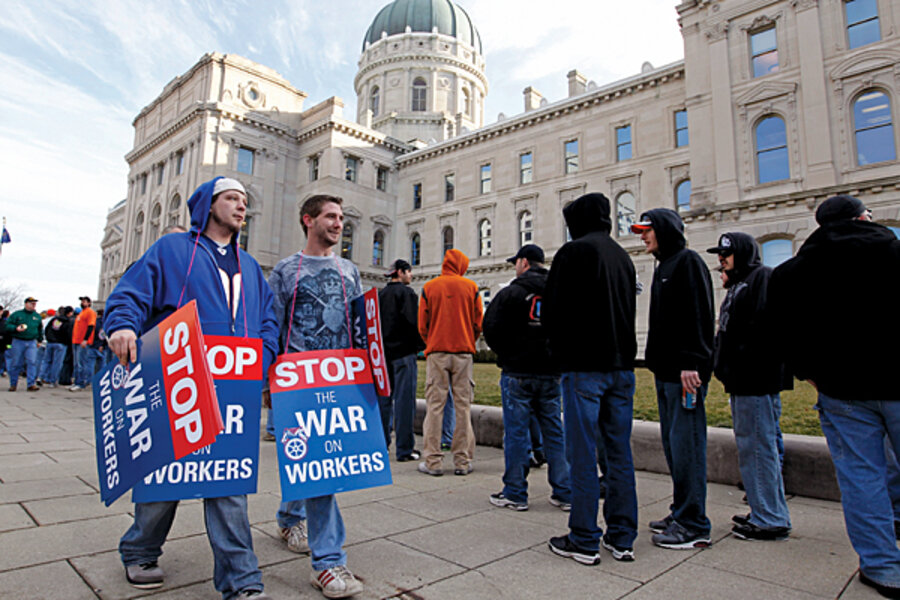Indiana 'right to work' law: what it means for the pro-union Rust Belt
Loading...
After a protracted battle, Indiana in early February elected to make union dues optional for workers in union jobs. It's the first state in more than 10 years to adopt a so-called right-to-work law and the first state ever in the industrial Midwest to go that route.
What this means for Indiana is hotly debated. The law's backers expect it to attract more businesses and jobs to the state, and its detractors warn of lower wages for all workers.
The new law takes effect amid a climate of contention around union issues in other Midwestern states – with mixed outcomes. In Wisconsin, a Republican takeover of state government in 2010 led to a new law restricting collective bargaining for most unionized public employees.
But in Ohio, voters last fall turned back a similar measure that had been approved by that state's GOP-led lawmakers. Governors of both states, along with Gov. Rick Snyder of Michigan, have said they don't plan on moving toward right-to-work legislation.
Despite disavowals from these governors, it remains to be seen if other states might follow Indiana's lead, says Martin Malin, director of the Institute for Law and the Workplace at Kent College of Law in Chicago. "It's almost impossible to read the political momentum" because, he says, "as union membership declines the political calculation changes."
Inside Indiana, both sides agree that the new right-to-work law will have a significant impact, though they disagree over whether the positives outweigh the negatives. The law specifically rules out labor contracts that require workers to pay a fee for union representation.
Unions in the state say the law may not hurt them right away, but they foresee a corrosive effect over time on union clout.
"It's going to be a while before we see the effects," says Ricky Wayman, an electromechanic at Verallia, a maker of glass beverage and food containers in Dunkirk, Ind. Mr. Wayman echoes the concerns of most union workers in Indiana who say that the measure's real purpose is to drive down union wages and, with them, the unions' political clout.
"Over the course of time we're going to have declining membership. New hires are going to see it as a way to keep a little more money in their pockets, which, in effect, will deplete local union funds," he says. It will deplete bargaining power and limit any kind of political action, he adds.
Proponents of the law see right to work as a pro-business effort to attract companies to the state, which will ideally lead to new jobs.
Many companies looking to relocate will rule out places that do not have right-to-work laws, says Rob DeRocker, an economic development consultant in Tarrytown, N.Y.
"The lack of a right-to-work law suggests that the mentality at the government level is that it's not a business-friendly state," Mr. DeRocker says. "Rightly or wrongly, it's an issue."
Right-to-work supporters also say the measure promotes the individual liberty of workers, giving them the choice whether or not to join a union – and perhaps more important, pay membership dues.
Many union workers don't agree with the politicking associated with organized labor, and they should have the right to withdraw their dues in protest, says Mark Mix, president of the National Right to Work Committee, a nonprofit advocacy organization in Springfield, Va.
"The reason union officials are scared of right to work is they're worried that if workers in Indiana have a choice to support them, some will choose not to," he says.
Indiana is the 23rd state to adopt right-to-work legislation. The law is more prevalent in the South and West than it is in the Midwest.
Some in Indiana, like state Rep. Jerry Torr, who wrote the bill, hope that the Indiana victory will result in subsequent right-to-work measures spreading through the Midwest's traditional manufacturing belt.
But it's unclear whether the legislation will have broader support.
Indiana has the lowest union workforce in the Rust Belt, which is another reason why right to work easily passed there and why similar legislation faces bigger hurdles in states close to its borders.
Along with Gov. Scott Walker of Wisconsin and Gov. John Kasich of Ohio, Governor Snyder in Michigan says right-to-work legislation is not on his agenda. He told lawmakers in January not to propose a bill because it would be too divisive and would distract from creating jobs immediately.
What's more, there is little worry that companies will suddenly uproot and move to Indiana, except in a few bordering counties where the "transportation costs and workforce availability are going to be the same," says Donald Grimes, a senior research associate at the Institute for Research on Labor, Employment, and the Economy at the University of Michigan in Ann Arbor.
After all, Montana, Colorado, and New Mexico all sustain strong economies despite sharing borders with right-to-work states, he says.
In Indiana, the right-to-work law will most certainly cripple the finances of the state's Democratic Party – which some say was the real motivation behind the legislation.
"There is clearly a political motive [by Republicans] behind weakening what is clearly a strong force within the Democratic Party," says Robert Bruno, director of the Labor Education Program at the University of Illinois in Chicago.
The Democratic Party in Indiana receives one-third of its funding from organized labor. Unlike other Midwest states with strong progressive communities, Indiana has a political spectrum in which liberals come mainly from unions, making unions even more valuable to Democrats.
"At the end of the day, most of our members feel [right to work] is more about politics than about economics," says Jeff Harris, a spokesman for the Indiana chapter of the AFL-CIO. "This is political payback and about rewarding friends and kicking out enemies."





